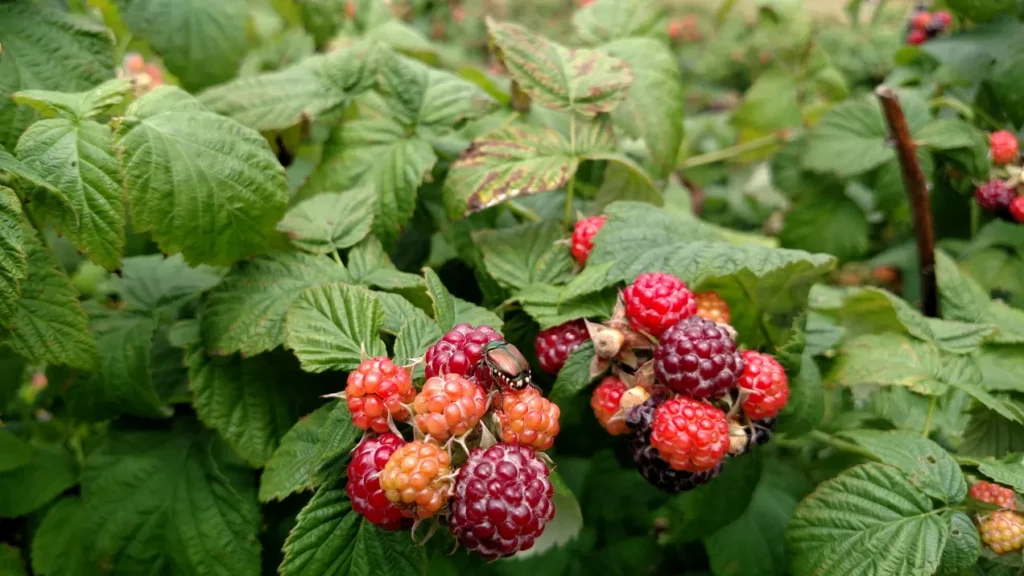How to Manage Japanese Beetles
Thanks to the University of Maryland/Maryland Grows this informative article on how to manage Japanese beetles.

Photo: Miri Talabac, University of Maryland Extension.
Q: Japanese beetles have been ravaging my yard for a few summers now. I heard Milky Spore can be a natural way to treat them. Is that right?
A: Japanese beetle grubs feed underground on plant roots (often in lawns). The adults feed on foliage and flower petals on perennials, shrubs, and trees. It’s possible only one of those two life stages will pose a problem for a gardener while the other does not. You won’t necessarily have to tackle both. In fact, a lot of lawn grub treatments are unnecessary. This is because any grubs encountered are not abundant enough to create noticeable lawn damage, or someone mistakenly blamed grubs for turf dieback caused by other factors.
Milky Spore, the product name for a biological control agent for Japanese beetle grubs, is a naturally-occurring bacteria that infects the grubs and kills them. Unfortunately, University field trials have found it is not reliably effective. Microbial levels might require several years of build-up from annual applications of the product to reach populations sufficient to reduce grub numbers, which can be costly.
You do have other options; the adults of this species won’t be out for a month or so yet. Beneficial nematodes can be applied to a lawn where white grubs feed, which will parasitize them and kill them. Weather conditions need to be just right during application because they are very perishable. However, once nematodes get settled in, they appear to be a more promising solution.
Lower-toxicity insecticides can be used as a last resort, though check with local government rules about applications to turf since some areas restrict pesticide use on home lawns. It may be best (or necessary, for certain ingredients) to hire a certified pesticide applicator to make such treatments.
Residents who have a lawn dominated by tall fescue will rarely have any serious Japanese beetle grub issues, because this is not the turf type they prefer. (Kentucky bluegrass, fine fescue, and perennial ryegrass are those at risk.)
Adult beetles are simpler to deal with. Simply hand-picking them off of shrubs is an immediately effective tactic. Knock them into a container of soapy water to kill them, since they drop readily when disturbed. These beetles like to congregate. Removing them in the morning, before they can produce a waft of aggregation pheromone to attract others to the banquet, means that you can easily reduce the plant’s risk of damage.
It’s not necessary to nab every last beetle or prevent all chewing damage. Birds, lizards, predatory insects, and other natural helpers will help keep populations suppressed as well.
Although hanging trap bags use a pheromone lure, they attract more beetles than they capture. In addition, the incoming beetles might still eat plants before heading to their doom, so you might as well skip that approach and just intervene by hand.
Don’t worry too much if damage sneaks up on you. Even heavily-chewed shrubs may surprise you by rebounding well on their own, once the adult beetle activity has ended later in the summer. More information about their life cycle and management options can be found on our White Grub Management on Lawns and Japanese Beetles on Trees, Shrubs, and Flowers pages.
By Miri Talabac, Horticulturist, University of Maryland Extension Home & Garden Information Center. Miri writes the Garden Q&A for The Baltimore Sun and Washington Gardener Magazine. Read more by Miri.
Have a plant or insect question? The University of Maryland Extension has answers! Send your questions and photos to Ask Extension. Our horticulturists are available to answer your questions online, year-round.
In addition, if you are looking to buy or sell your home (with or without a garden), contact Gigi today.
Oh by the way, I’m never too busy for any of your referrals!






Recent Comments